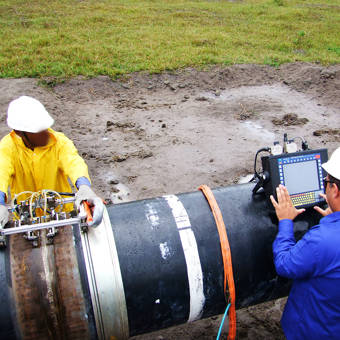Experience Quality: Premier Pipeline Welding Inspection Solutions You Can Depend On
Experience Quality: Premier Pipeline Welding Inspection Solutions You Can Depend On
Blog Article
Comprehensive Overview of Pipe Welding Inspection Procedures
In the world of pipe building, ensuring the honesty and safety of welded joints is critical. Pipeline welding evaluation procedures play a critical duty in assuring that bonded connections meet strict sector standards and requirements. From precise pre-welding evaluations to extensive post-weld evaluations, a distinct examination process is essential for preserving the structural soundness of pipelines. Understanding the ins and outs of welding examination treatments is not just a regulative demand but also a basic facet of maintaining the dependability of these vital infrastructures.
Pre-welding Assessment Preparations
Prior to beginning the welding process, extensive pre-welding assessment preparations are vital to guarantee the integrity and quality of the weld joint. These prep work include a precise examination of the products to be welded, the welding devices, and the job setting. By carrying out comprehensive pre-welding inspection prep work, potential concerns can be determined and dealt with early on, leading to high-quality and trusted weld joints.
Welding Procedure Certification
Comprehensive pre-welding examination preparations lay the structure for the crucial procedure of Welding Procedure Credentials, guaranteeing the honesty and quality of the weld joint. Welding Procedure Credentials (WPQ) is a vital action in the welding process that entails screening and accrediting welding treatments to ensure they meet certain criteria and requirements. The WPQ process generally consists of welding treatment specification advancement, welding treatment qualification screening, and documents of the results.
During welding treatment requirements development, necessary information such as the welding process, welding materials, joint style, and welding criteria are specified to create an extensive treatment. Ultimately, welding treatment qualification testing is carried out to confirm the recommended treatment's integrity. This testing typically entails welding examination discount coupons that undergo various mechanical and non-destructive tests to analyze the weld's quality and adherence to the specified criteria.
In-process Weld Examination
Throughout the welding process, in-process weld inspection plays a vital duty in ensuring the quality and stability of the weld joint - Pipeline Welding Inspection. This sort of assessment includes keeping an eye on the welding criteria, analyzing the weld grain development, and finding any kind of possible flaws or interruptions as they happen. By carrying out in-process weld assessments, welding operators can quickly deal with any issues that might emerge, consequently stopping more flaws and making certain that the last weld meets the called for requirements
Typical methods made use of for in-process weld examination include visual examination, fluid penetrant testing, magnetic fragment testing, ultrasonic testing, and radiographic screening. Visual examination is usually the very first step while doing so, allowing assessors to aesthetically examine the weld for surface irregularities such as splits, porosity, or incomplete blend. Much more innovative techniques like ultrasonic testing and radiographic screening offer detailed understandings into the interior structure of the weld, making certain that there are no covert issues that might endanger the weld joint's stamina and honesty. In general, in-process weld examination is vital for maintaining the high quality and integrity of welded pipes.
Non-destructive Testing (NDT)
Non-destructive Testing (NDT) is a critical method utilized in pipe welding examination to evaluate the stability of weld joints without creating damages to the bonded structure. By utilizing different NDT methods, assessors can assess the high quality of welds and recognize any kind of defects or gaps that might jeopardize the structural strength of the pipeline. Common NDT approaches utilized in pipeline welding inspection include Radiographic Testing (RT), Ultrasonic Testing (UT), Magnetic Particle Evaluating (MPT), Liquid Penetrant Testing (LPT), and Visual Testing (VT)
RT involves the usage of X-rays or gamma rays to generate pictures of the internal framework of the weld, enabling inspectors to spot issues such as look here porosity, splits, or incomplete fusion. In addition, VT includes aesthetic assessment of welds to determine any noticeable flaws.
Post-weld Inspection and Documents


Paperwork of post-weld examination searchings for is vital for maintaining quality control documents and guaranteeing compliance with market requirements and regulations. In-depth records must consist of info concerning the evaluation techniques used, the place and nature of any kind of defects discovered, and any kind of corrective actions taken - Pipeline Welding Inspection. Correct documentation not only acts as a record of the weld's high quality yet additionally aids in future maintenance and examination processes
Final Thought

In final thought, pipe welding assessment treatments play a crucial role in guaranteeing the quality and stability of welds. Generally, adherence to correct examination methods is vital to the success of pipe welding tasks.
From thorough pre-welding inspections to detailed post-weld analyses, a distinct assessment process is vital for preserving the structural stability of pipelines. By conducting in-process weld inspections, welding drivers can without delay attend to any type of problems that may arise, thereby guaranteeing and avoiding further issues that the last weld meets the called for specs.
Common approaches utilized for in-process weld evaluation consist of visual inspection, fluid penetrant testing, magnetic fragment screening, ultrasonic testing, and radiographic screening.Non-destructive Testing (NDT) is a critical approach employed in pipe welding evaluation to assess the stability of weld joints without causing damages to the welded framework. Post-weld inspection news entails various approaches to evaluate the welds for issues, including aesthetic inspection, dye penetrant testing, magnetic fragment screening, ultrasonic testing, and radiographic testing.
Report this page